When it comes to raising fish, there’s probably no species that offers more options in terms of colors, patterns, body shape and fin arrangements than the goldfish. Did you know that they were one of the first species to be domesticated and selectively bred? There are more than 200 types of goldfish around the world!
If you’ve only seen a tank of feeder fish or a few of the weird goldfish varieties, you may be surprised to discover how diverse this species truly is. Allow me to introduce you to this large and fascinating family of fish and help you identify the best types for your goldfish aquarium or pond!
Introduction to Hearty and Fancy Goldfish Varieties
There are several ways to identify plain and fancy goldfish (Carassius auratus) based on their body shape, pigments and patterns of color, their type of scales, and other unique traits like head and tail morphology. Goldfish are most commonly grouped into breeds or varieties, but these categories are quite loose and fluid.
The name of a fish is a big hint about what it looks like and can offer you clues to finding the best goldfish types for aquariums or outdoor ponds. Some breeds are known for being especially hearty and durable while others are delicate and need more intensive care.
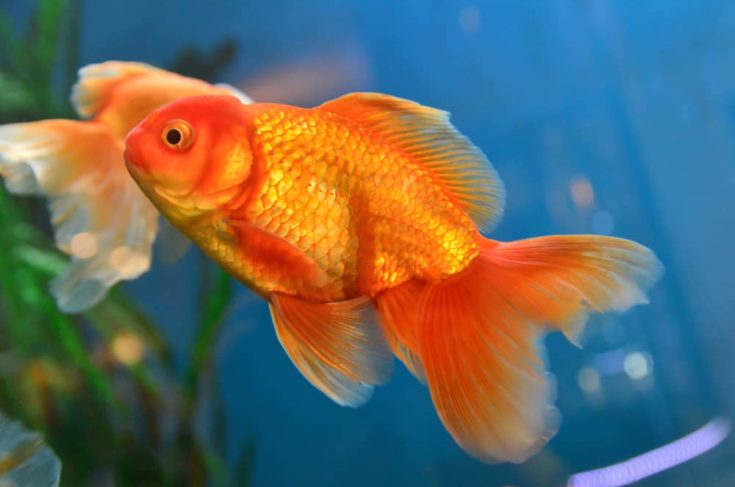
Common Names
Goldfish (Carassius auratus)
Family
Cyprinidae
Temperament
Peaceful, social and curious
Care Level
Varies by breed
Diet
Omnivore; Ideal diet varies by breed
Average Size
8 to 12 inches from snout to tail at maturity
Water Hardness
Does well with either soft or hard water
pH Range
6.0 to 8.0
Water Current
They don’t like swift water currents and these hard currents can harm the delicate fancy breeds. They prefer well-oxygenated water but can survive in stagnant conditions as long as the water is clean
Water Quality and Filtration
Goldfish are very sensitive to ammonia and need very clean water to thrive. Because they are such voracious eaters they produce a lot of biowaste. 3-stage low-flow filtration with weekly water changes is ideal
Goldfish Breeds—A Detailed Guide to 32 Popular Types
It’s time to talk about the most popular breeds of goldfish and how they differ in their appearances and care requirements. Narrowing down your list to find the best breed of goldfish depends on whether you’re stocking a pond or an aquarium, but from there the options are wide open!
Single Tailed Goldfish Breeds
Single tailed goldfish are hearty and easy to care for in an outdoor pond or appropriate size aquarium. They are not sensitive to their water temperature but prefer clean, filtered water with minimal current. Single tails enjoy exploring a tank with decorations, plants and hiding places but also need room to swim.
Common Goldfish aka Feeder Goldfish
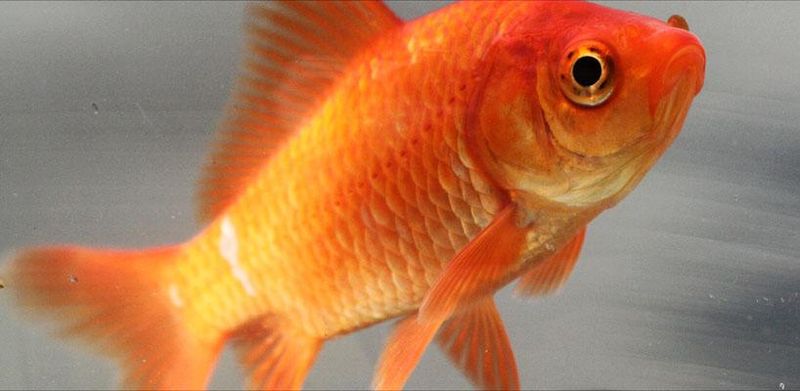
Common goldfish don’t usually get much attention from lists like this, but many of us start with tanks of these inexpensive fish! It really doesn’t get much easier than maintaining a common goldfish. They have a wide range of acceptable temperatures, and while they don’t need a heater they often do just fine in tropical set-ups.
Are feeder fish the same thing as common goldfish? It depends on the store. Commons are not always lower-quality feeder fish and many stores maintain tanks of brightly colored fish for stocking aquariums and outdoor ponds. These fish may be more expensive than their stock of feeders, however.
Feeders are usually small, plain grey/brown goldfish culled from groups of their more colorful and rapidly developing siblings. Their hardiness is identical to other common goldfish, but they are often packed tightly in aquarium store tanks and may not be fed or maintained as well.
Breed
Common Goldfish, Feeder Goldfish
Unique Trait
N/A
Care Level
Easy
Ideal Diet
Commercial goldfish flakes or pellets supplemented with live/frozen foods such as brine shrimp
Scale Type
Metallic scales
Pattern
Can be any color or mix of colors other than calico, but the most common patterns are self-colored or bi-colored. Feeder tanks are often considered multicolored
Colors
Grey/brown, red/orange, and white/silver are most common
Average Size
2 to 4-inches for juveniles; 10 to 12-inches at maturity, although there are many reports of these fish reaching 14 inches or longer
Minimum Tank Size
10 gallons for juvenile; 20 gallons for adult
Add 10 to 15 gallons per adult
Ok for Ponds
Yes
Temperature Range
Coldwater 60 to 80°F
Compatibility with Tank Mates
Compatible with other single tail goldfish, peaceful community fish or koi with similar care requirements. Avoid housing with aggressive fish or small snails or shrimp which might get eaten
Comet Goldfish
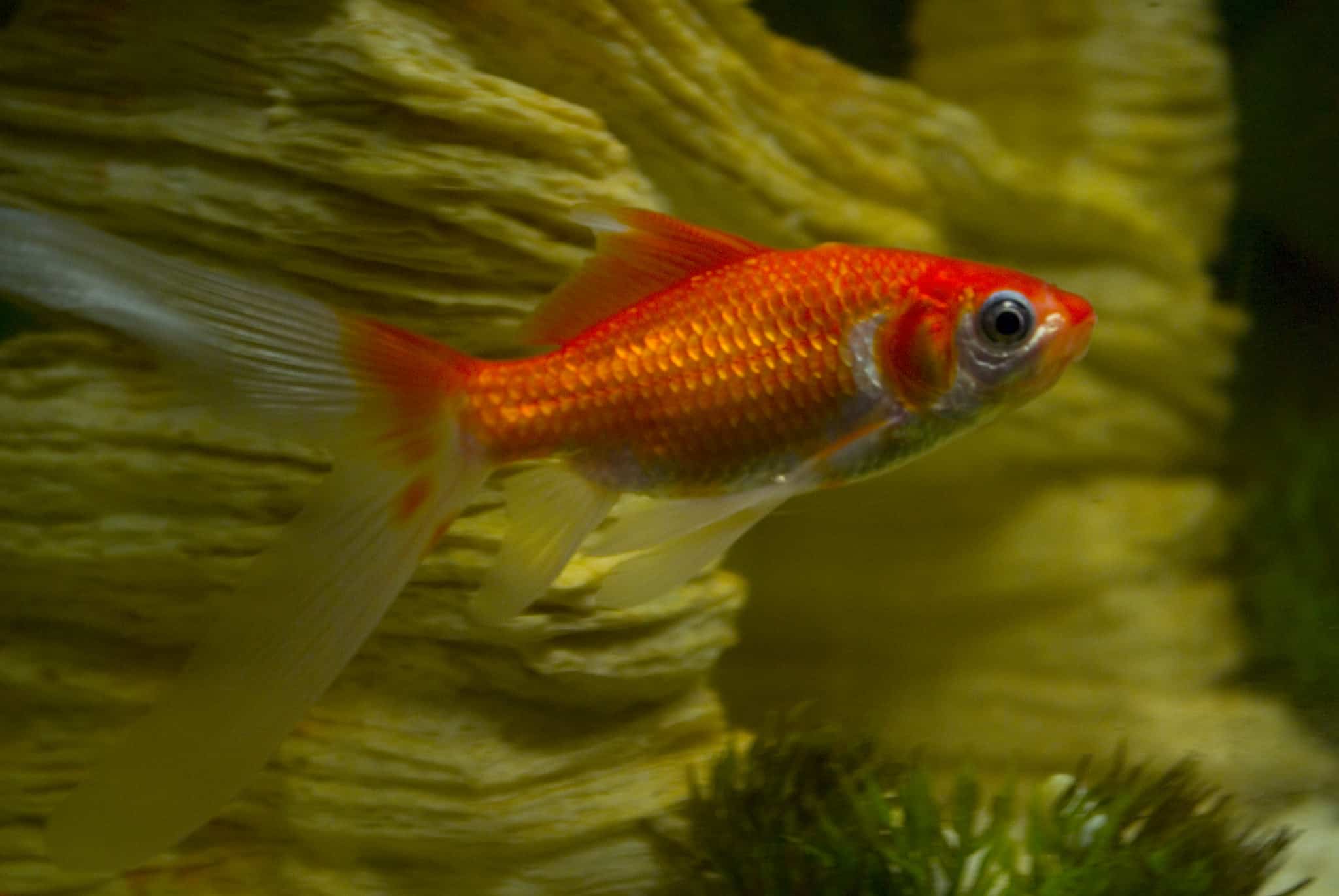
Comet goldfish have a slightly shorter, leaner body than the Common breed but have a distinctive widespread long tail with sharp points. They need a bit more room than the Common goldfish so they don’t injure their tail on their substrate or decor. These goldfish are active and attractive, and are one of the most popular breeds of goldfish!
They are coldwater fish and do well in ponds, but you can also keep them in heated aquariums. Comets are usually deeply colored with a vivid red or orange hue, which looks amazing in a pond. Most comet goldfish are self or bi-colored, and they typically come in Red and White or Sarassa morphs.
Breed
Comet Goldfish
Unique Trait
Long, flowing single tail that spreads out; the slender body is shorter than the Common
Care Level
Easy
Ideal Diet
Commercial goldfish flakes or pellets supplemented with live/frozen foods such as brine shrimp
Scale Type
Metallic scales
Pattern
Usually self-colored or bi-colored. Red and White’s are the most common but this breed also comes in Sarassa morphs
Colors
Red/orange, white, yellow, green or chocolate
Black Comets are not true comets but rather a hybrid koi/goldfish species
Average Size
2 to 4 inches for juveniles; 10 to 12 inches in length at maturity
Minimum Tank Size
15 gallons for juvenile; 50 gallons for adult
Add 50 gallons per adult
Ok for Ponds
Yes
Temperature Range
Coldwater 60 to 80°F
Compatibility with Tank Mates
Compatible with other single tail goldfish, peaceful community fish or koi with similar care requirements. Avoid housing with aggressive fish or small snails or shrimp which might get eaten
Nymph Goldfish
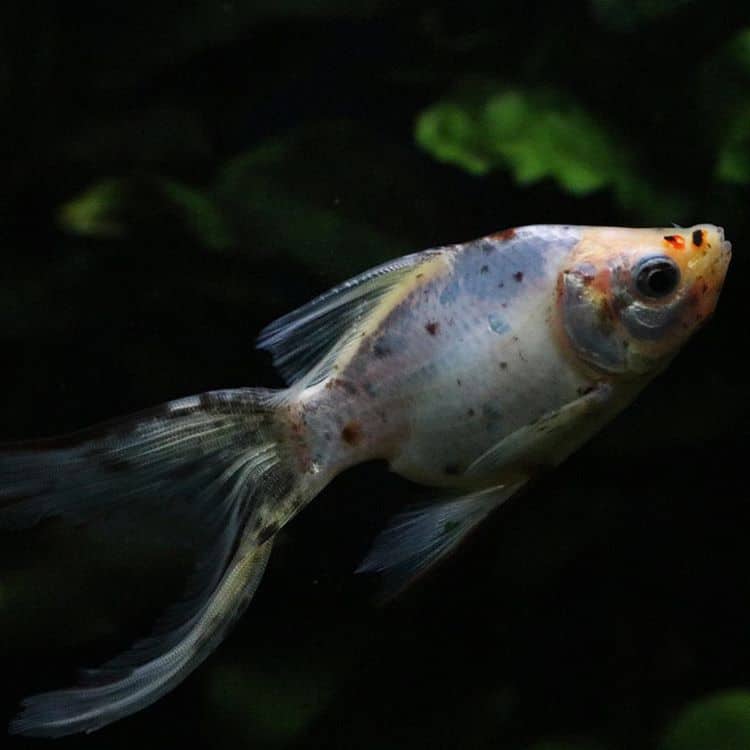
You don’t see many Nymph goldfish for sale these days, but these fish were rather popular about 15 years ago and have since gone out of fashion. These hearty fish are some of the best swimmers in the goldfish family, which is funny given their egg-shaped body and a long single tail. Some have telescopic eyes, too.
Despite their name, Nymphs are not small fish and can grow up to 12 inches in length. It’s thought they were initially a cross between a Comet and a Fancy Fantail, although these days the trait usually shows up as a recessive trait in Fantail and Veiltail crosses. They are easy to maintain in a pond or large aquarium.
Breed
Nymph Goldfish
Unique Trait
Has the egg-shaped body of a fantail with the single tail of the hearty goldfish. Thought to be a cross of a Comet and Fancy Fantail
Care Level
Easy
Ideal Diet
Commercial goldfish flakes or pellets supplemented with live/frozen foods such as brine shrimp
Scale Type
Metallic scales
Pattern
Usually self-colored or bi-colored
Colors
Red/orange, white, yellow, green or chocolate
Any color except calico
Average Size
1 to 3 inches for juveniles; 10 to 12 inches in length at maturity
Minimum Tank Size
10 gallons for juvenile; 20 gallons for adult
Add 10 to 15 gallons per adult
Ok for Ponds
Yes
Temperature Range
Coldwater 60 to 80°F
Compatibility with Tank Mates
Compatible with other single tail goldfish, peaceful community fish or koi with similar care requirements. Avoid housing with aggressive fish or small snails or shrimp which might get eaten
Shubunkin Goldfish
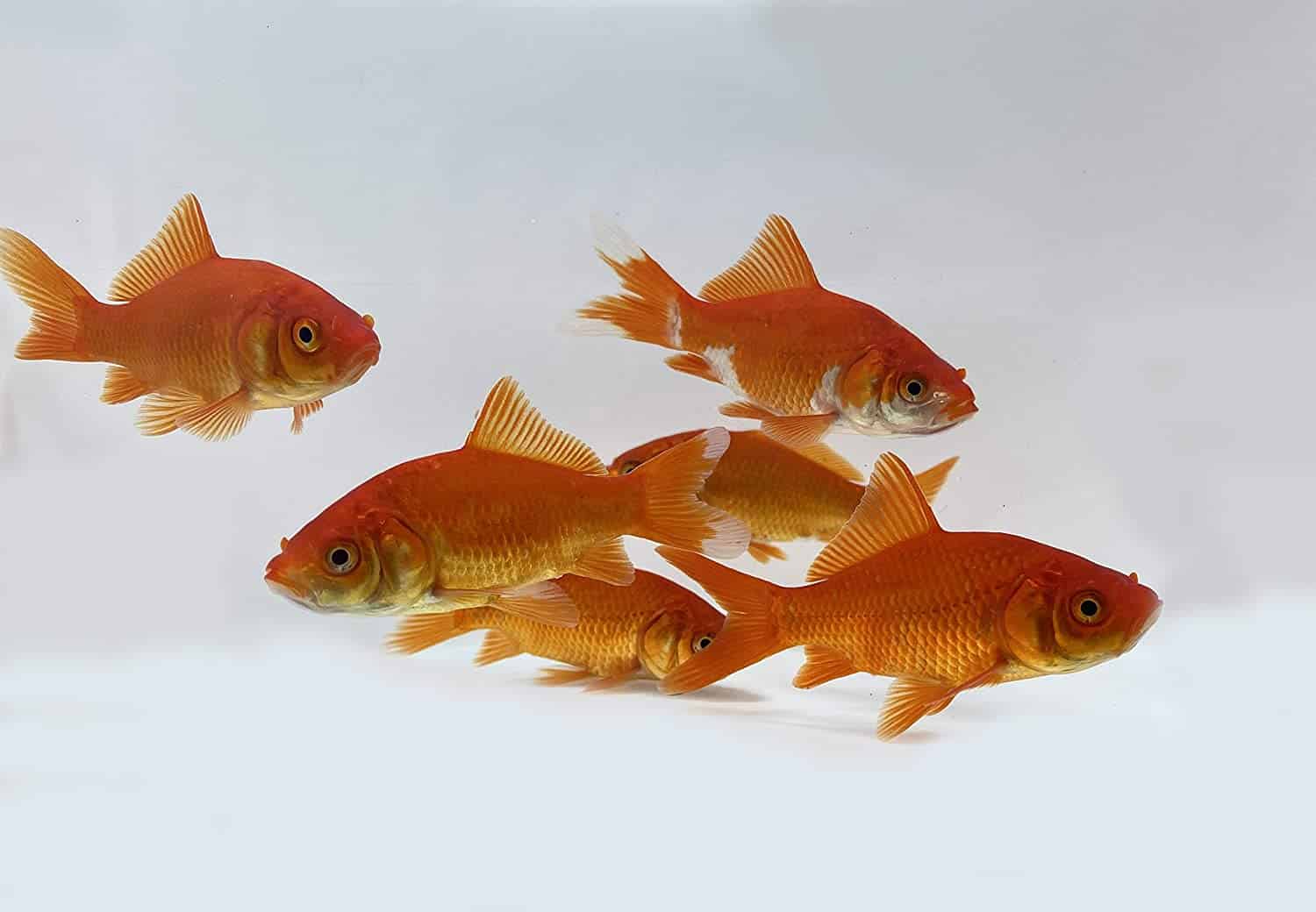
My favorite breed of goldfish are the mysterious Shubunkin. They can be very confusing for folks new to goldfish keeping, because any single tail fish that’s calico colored is considered a Shubunkin. If you breed a Comet or Nymph goldfish with the calico trait it’s still technically called a Shubunkin. The color morph dictates the breed.
Even fancy goldfish with a calico morph can be referred to as Shubunkins, although some sellers still list them as calico. If you see a fancy breed of goldfish referred to as a “Shubunkin-type” you can guarantee it’s a calico colored fish. There are three types of Shubunkin goldfish, and their differences can be quite subtle.
American/Japanese Shubunkin
The American (also called the Japanese ) type of Shubunkin is characterized by its tail. Their tail is longer than the other types with sharp points and a deep fork. Many consider the American or Japanese Shubunkin to be the original form, and the others likely descended from them.
Bristol Shubunkin
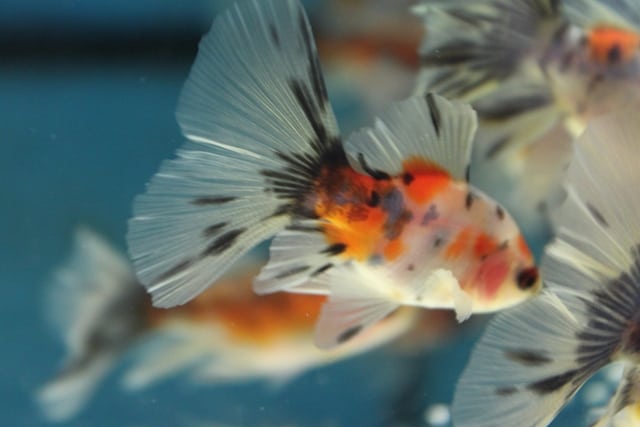
The Bristol type of Shubunkin has a slender body similar to the Comet with a distinctive, large pointed tail.
London Shubunkin
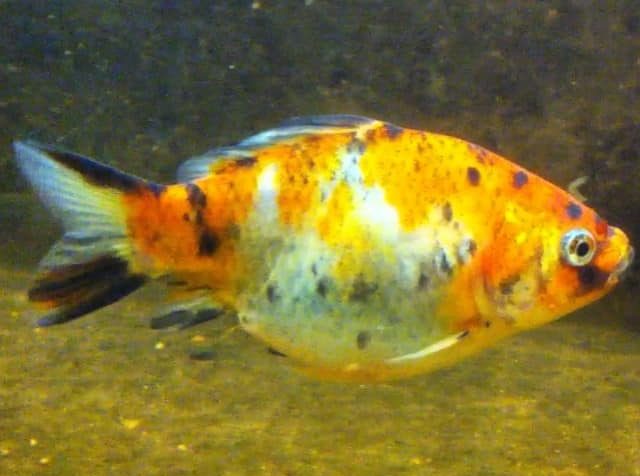
The final type of Shubunkin is the London form, which has a slender body with shorter, rounder tail fins.
Breed
Shubunkin or Calico Goldfish
Unique Trait
Nacreous scales with calico color morph; body and tail shape determines the specific type of Shubunkin (American, Bristol or London)
Care Level
Easy
Ideal Diet
Commercial goldfish flakes or pellets supplemented with live/frozen foods such as brine shrimp
Scale Type
Nacreous
Pattern
Calico
Colors
Base color is usually blue with white, black or red/orange patches or speckles. Scales can bring out iridescent blue/purple hues in some lighting conditions. Black is usually a stable color in calico goldfish
Average Size
2 to 4 inches for juveniles; 10 to 12 inches in length at maturity
Minimum Tank Size
10 gallons for juvenile; 20 gallons for adult
Add 10 to 15 gallons per adult
Ok for Ponds
Yes
Temperature Range
Coldwater 60 to 80°F
Compatibility with Tank Mates
Compatible with other single tail goldfish, peaceful community fish or koi with similar care requirements. Avoid housing with aggressive fish or small snails or shrimp which might get eaten
Tamasaba or Sabao Goldfish
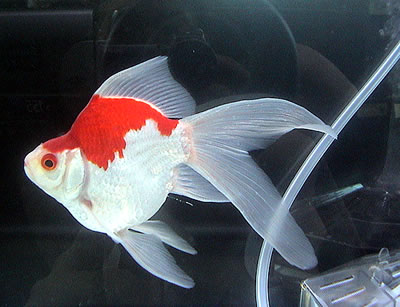
This rare Japanese goldfish is not seen very often, but the Tamasaba is a brightly colored red or red/white goldfish with an egg-shaped body and long single tail. Their tail is said to resemble a mackerel’s tail. They were originally bred from Ryukin stock, and you can see the distinctive hump they’ve inherited from their ancestors.
These hearty round fish make excellent options for koi ponds, where they add an interesting look compared to the leaner koi. They do well in large aquariums but shouldn’t be kept with other types of single tails. They are fairly difficult to find these days, and there isn’t much information about them online.
Breed
Tamasaba, Sabao or Mackerel Tailed Goldfish
Unique Trait
Round egg-shaped body with an arched back and long single tail with rounded points
Care Level
Easy to Moderate
Ideal Diet
Commercial goldfish flakes or pellets supplemented with live/frozen foods such as brine shrimp
Scale Type
Metallic
Pattern
Self-colored or bi-colored
Colors
Usually red/orange or Red and White
Average Size
1 to 2 inches for juveniles; 8 to 10 inches in length at maturity
Minimum Tank Size
10 gallons for juvenile; 20 gallons for adult
Add 10 to 15 gallons per adult
Ok for Ponds
Yes
Temperature Range
Coldwater 60 to 80°F
Compatibility with Tank Mates
Best kept with other Tamasaba goldfish or with koi rather than other breeds of single tail goldfish. Avoid housing with aggressive fish or small snails or shrimp which might get eaten
Double Tail Goldfish—Fancy Breeds
Goldfish with double tails are always fancy types of fish with a round, egg-shaped or hunched body. These goldfish are more sensitive to their water conditions and usually (but not always) need warmer aquariums that maintain a consistent temperature. They can’t swim very fast and most are unsuited to life in a pond.
You can often keep different breeds of fancy goldfish in the same aquarium as long as they have plenty of room, but avoid keeping them with the single tails. The slower fancies just can’t compete with them for food. Mix fancies based on their physical traits and keep the delicate breeds separate from the heartier ones like Fantails.
Some of these breeds have physical traits that make them very prone to accidental injury, like the Celestial and Bubble Eyes. You may need to adjust your decor or equipment to keep your fish safe from harm. You’ll definitely need an aquarium heater and low-flow filter for your delicate goldfish tank.
Fantail Goldfish
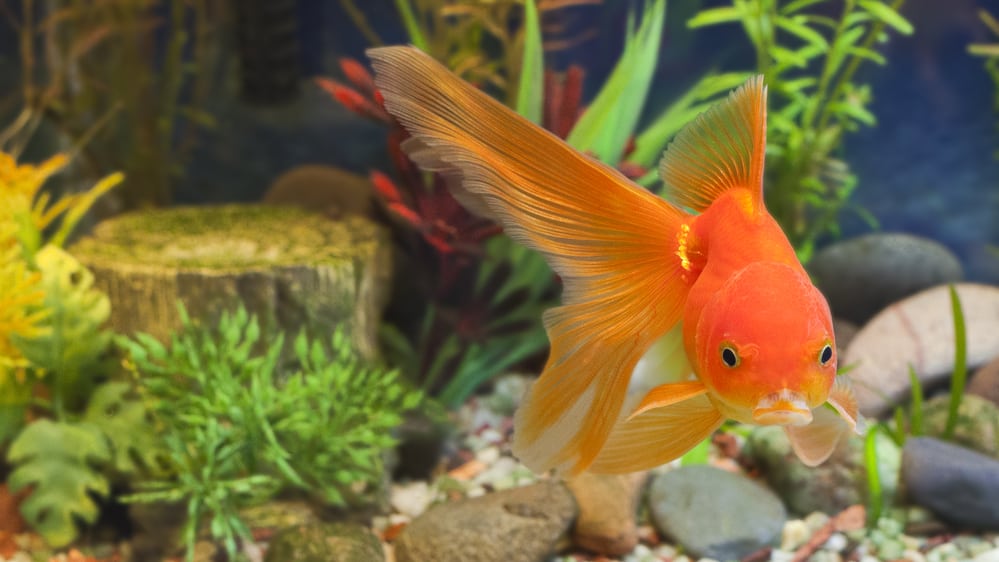
If you’d like to leap into the world of fancy goldfish you couldn’t pick a better starter fish than the Fantail! While these fish require more precise conditions than the single tails they are still one of the easier goldfish to care for. Fantails have the classic egg-shaped bodies and lovely, long double tails that give them their name.
Fantails are the foundation breed for nearly all of the fancy goldfish and are routinely bred back into these lines to keep them genetically healthy. They prefer warmer water than hearty goldfish and usually require an aquarium heater. Their tails make them slightly awkward swimmers but they don’t need a high level of special care to thrive.
Breed
Fantail or Fancy Fantail Goldfish
Unique Trait
Egg-shaped body with a long double tail; fish with extra-long tails may also be termed “Ribbon-tailed Fantail”
Care Level
Easy to Moderate
Ideal Diet
Commercial goldfish pellets are best, although strong swimmers may be able to catch flake foods. Supplement with live/frozen foods such as brine shrimp
Scale Type
Metallic is most common but may come in nacreous or matte forms
Pattern
Self-colored or bi-colored; Red and White most common but calico morphs are not unusual
Colors
Usually red/orange or yellow. Black, white, and koi-colored morphs are often available in Japan
Average Size
1 to 2 inches for juveniles; 6 to 8 inches in length at maturity
Minimum Tank Size
10 gallons for juvenile; 15 to 20 gallons for adult
Add 10 gallons per adult
Ok for Ponds
No
Temperature Range
70 to 80°F; Technically not a tropical fish but does better in warmer conditions
Compatibility with Tank Mates
Best housed with similar breeds of Fancy goldfish with the same care requirements, like the Ryukin. Avoid keeping in community aquariums or with single tail hearty goldfish breeds
Veiltail Goldfish
If you like the look of the Fantail but are up for a challenge then consider the impressive Veiltail goldfish. They have a rounder and slightly more compact body but what makes them a showstopper is their flowing 4-inch long tail and dorsal fin. Veiltails are the most Betta-like of all of the goldfish with their fancy fins!
Veiltails are harder to maintain because those fins limit their movements and can be easily damaged on your decor. They can’t hunt for food scraps very well either, and are best fed a floating diet they can see and easily catch. They need plenty of room to maneuver around your tank and are too delicate for community aquariums.
Breed
Veiltail Goldfish
Unique Trait
Compact round body with a long, flowing dorsal fin and elongated, well-separated 3 to 4-inch double tail
Care Level
Moderate to Hard
Ideal Diet
Commercial goldfish pellets that float are best since these fish can’t swim very well. Supplement with live/frozen foods such as brine shrimp
Scale Type
Metallic is most desirable but may come in nacreous or matte forms
Pattern
Self-colored or bi-colored are most common but may also come in calico morph
Colors
Usually red/orange or Red and White
Average Size
1 to 2 inches for juveniles; 7 to 8 inches in length at maturity
Minimum Tank Size
10 gallons for juvenile; 15 to 20 gallons for adult
Add 10 gallons per adult
Ok for Ponds
No
Temperature Range
70 to 80°F
Compatibility with Tank Mates
Best housed with similar breeds of Fancy goldfish with the same care requirements, like the Bubble Eye or Celestial. Avoid keeping in community aquariums or with heartier goldfish breeds
Butterfly Tail Goldfish
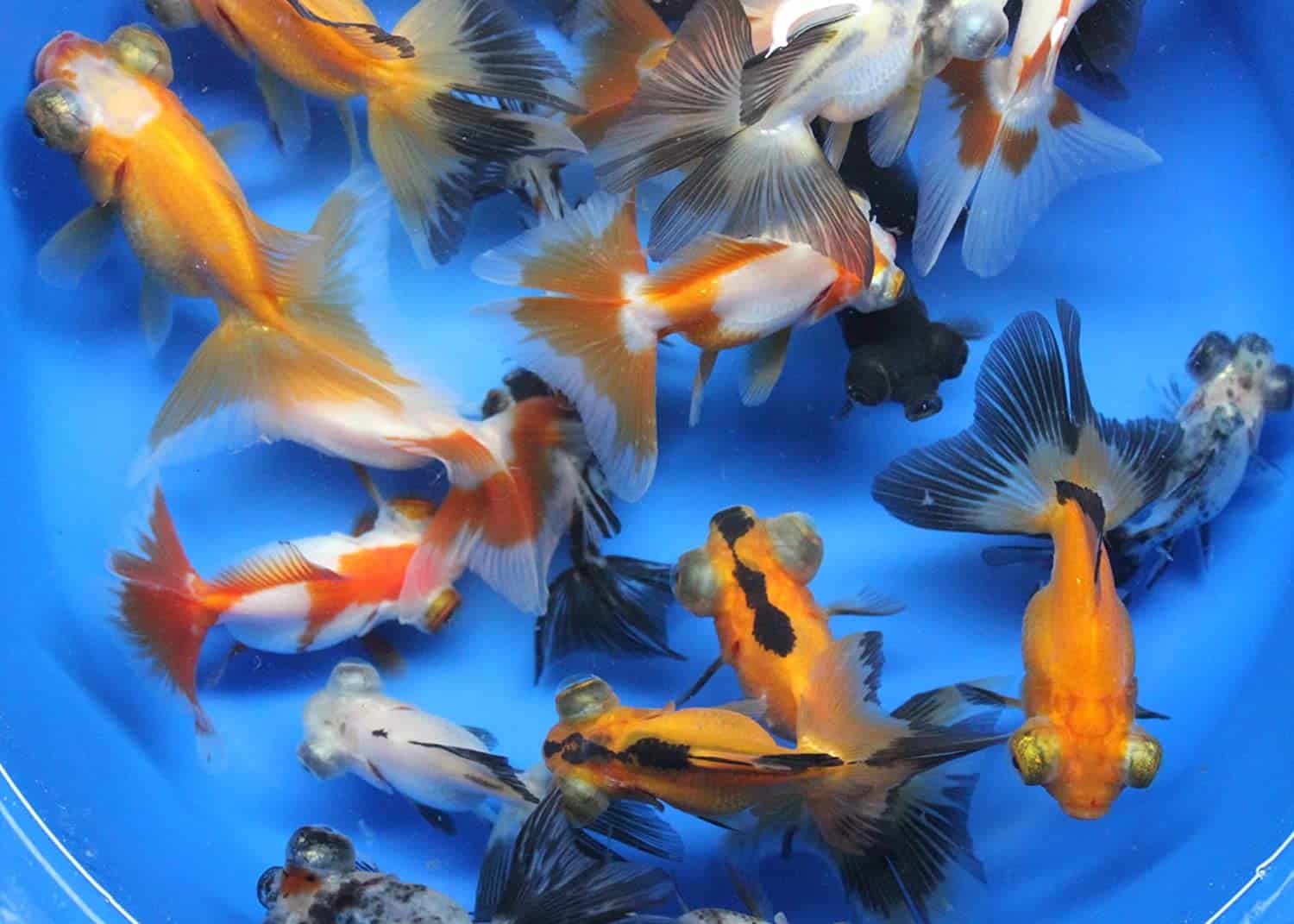
Another showy breed known for their fancy fins, the Butterfly Tail goldfish were bred to be observed from overhead. They have a hunched Ryukin-style body with a long, widely-spread double tail that looks like a butterfly when you look down on them. Butterflies often come with other fancy traits like telescopic eyes or hoods.
These goldfish are currently very popular with breeders and come in a wide variety of scale types, patterns, and colors. Recently, varieties like the self-colored white matte, lavender and blue have become available as well, and more are sure to come!
Breed
Butterfly Tail Goldfish
Unique Trait
Round, hunched body with an elongated widely-spread double tail. Observed from overhead the tail resembles a butterfly. Often comes with telescopic eyes as in the Butterfly Moor morph or with other fancy traits
Care Level
Moderate to Hard
Ideal Diet
Commercial goldfish pellets that float are best since these fish can’t swim very well. Supplement with live/frozen foods such as brine shrimp
Scale Type
Metallic is desirable and the most common, but may come in nacreous or matte forms
Pattern
Self-colored or bi-colored are most common but may come in tri-colored and calico morphs
Colors
Panda is most desirable but Red and Black/Red and White morphs are also popular. Self-colored black is rarely stable and usually morphs to a Panda/Red Panda
Average Size
1 to 2 inches for juveniles; 7 to 8 inches in length at maturity
Minimum Tank Size
10 gallons for juvenile; 15 to 20 gallons for adult
Add 10 gallons per adult
Ok for Ponds
No
Temperature Range
70 to 80°F
Compatibility with Tank Mates
Best housed with similar breeds of Fancy goldfish with the same care requirements, like the Bubble Eye or Celestial. Avoid keeping in community aquariums or with heartier goldfish breeds
Wakin Goldfish
A rare fancy breed that does well in ponds and aquariums, the Wakin looks like a hybrid of a Common or Comet goldfish with a Fancy Fantail. They have a leaner streamlined body, an upright dorsal fin that goes almost all the way down its back, and a beautiful double tail that’s a bit shorter than a Fantail.
These strong swimmers are easily maintained and don’t have any special requirements other than needing plenty of room to reach their maximum size. Some of the pond-raised Wakins have reached nearly 19-inches in length! You’ll have a variety of colors and patterns to choose from as well.
Watonai Goldfish (Wakin Hybrid)
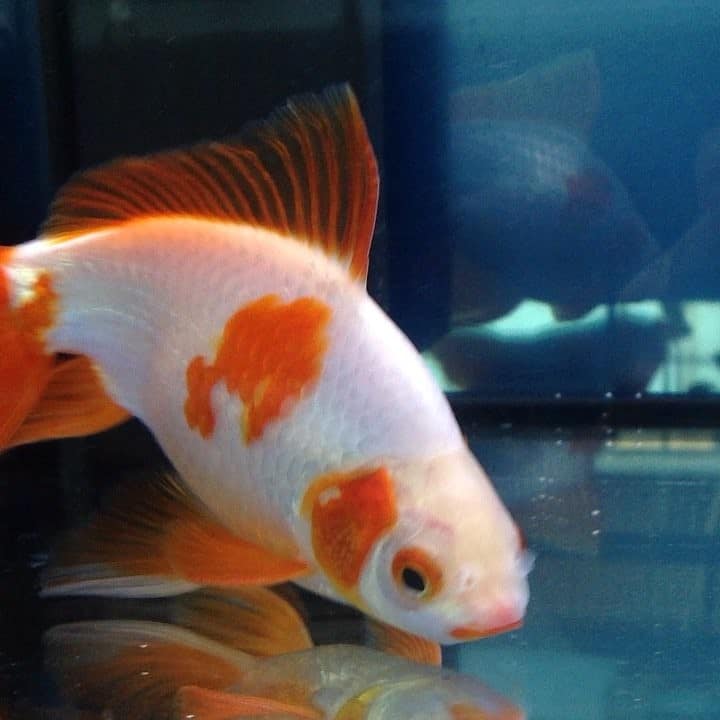
Rather than talk about them separately, I’m including the Watonai under the Wakin because they are closely related and have similar requirements. The Watonai has the same shape and colors as the Wakin but has a longer double tail. They are one of the fanciest breeds that can thrive in a pond and are not hard to care for!
Breed
Wakin Goldfish and Watonai Goldfish (Watonai hybrid)
Unique Trait
Leaner hearty-goldfish shaped body with an upright dorsal fin that extends down its spine and classic double tail.
The Watonai hybrid has a longer double tail, but care requirements are the same
Care Level
Easy to Moderate
Ideal Diet
Commercial goldfish flakes or pellets supplemented with live/frozen foods such as brine shrimp
Scale Type
Metallic is the most common, but may come in nacreous
Pattern
Traditionally self-colored or bi-colored, but recently available in calico morph
Colors
Red or Red and White are the most desirable but also comes in calico, chocolate, and yellow/orange morphs
Average Size
2 to 4 inches for juveniles; 10 to 12 inches in length at maturity, but there are reports of these fish reaching nearly 19-inches in pond settings
Minimum Tank Size
10 gallons for juvenile; 30 gallons for adult
Add 15 to 20 gallons per adult
Ok for Ponds
Yes
Temperature Range
Coldwater 60 to 78°F; often does well without a heater
Compatibility with Tank Mates
Does well in aquariums or ponds with Common, Comet or Shubunkin goldfish
Ryukin Goldfish
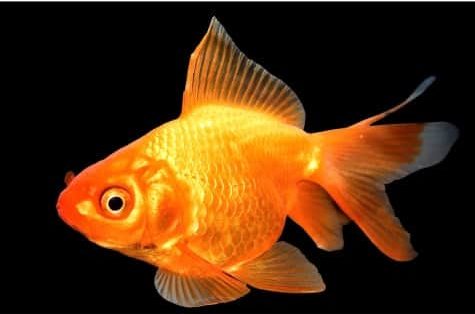
Another of my favorite breeds of goldfish, the Ryukin descends from the Fantail and is the foundation for many other breeds such as the Watonai and Butterfly. These fish have a noticeable hump in their backs that makes them as tall as they are long. They have a classic double tail and are one of the easier fancies to keep.
Like the other heartier fancy goldfish, Ryukin does well in ponds as long as their preferred warmer temperature is maintained with a heater. Or you can keep them in an aquarium with other goldfish. This is a good option if you’re looking for small goldfish breeds!
Breed
Ryukin Goldfish
Unique Trait
Round body with prominently humped back and classic double tail. Longer tailed fish may be called ribbon or fringe tailed
Care Level
Easy to Moderate
Ideal Diet
Commercial goldfish flakes or pellets supplemented with live/frozen foods such as brine shrimp
Scale Type
Metallic is the most common, but nacreous morph is available
Pattern
Self-colored, bi-colored, tri-colored or calico
Colors
Red, Red and White, calico, chocolate and white are the most common morphs
Average Size
2 to 4 inches for juveniles; 6 to 10 inches in length at maturity
Minimum Tank Size
10 gallons for juvenile; 20 to 30 gallons for adult
Add 10 to 15 gallons per adult
Ok for Ponds
Yes
Temperature Range
65 to 78°F; best to maintain temperature with a heater
Compatibility with Tank Mates
Does well in aquariums or ponds with Common, Comet or Shubunkin goldfish, or housed in an aquarium with other fancy Fantail, Lionheads or Orandas
Jikin or Peacock Goldfish
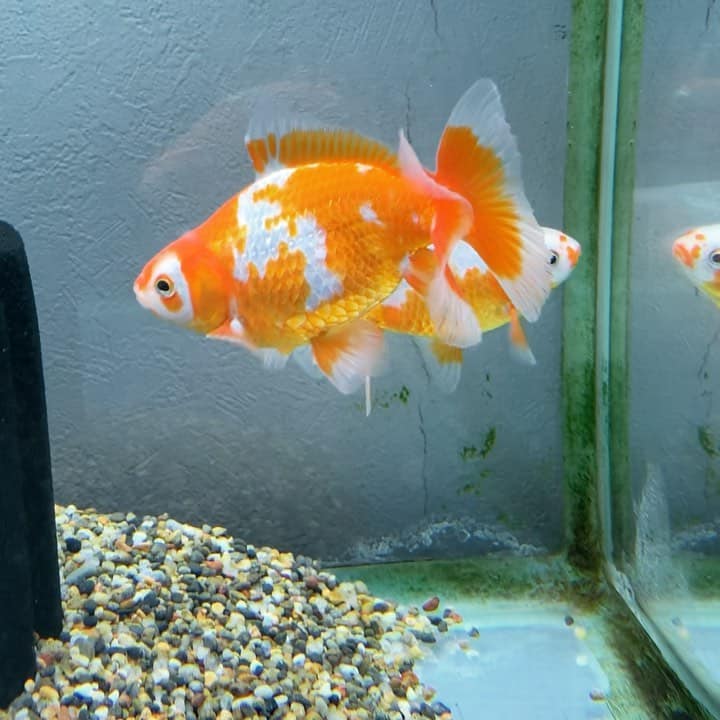
Another breed that’s often called a Butterfly or Peacock goldfish, the Jikin is a rare color morph from Japan. They usually have a longer body similar to the Common (though some have the hunched Ryukin trait) with a wide-spread tail that’s best appreciated from above.
Where the Jikin really stands out is for its unique color pattern. The desired color scheme is always bi-colored Red and White, but the only acceptable red is on the tail, fins, gill covers and lips. Red on any part of the body other than these “12-points” is undesirable and selected against.
Breed
Jikin Goldfish, Butterfly or Peacock Goldfish
Unique Trait
Body is usually leaner and more streamlined than most fancies with a long, wide-spread double tail. Color is what distinguishes this from other fancy breeds
Care Level
Easy to Moderate
Ideal Diet
Commercial goldfish flakes or pellets supplemented with live/frozen foods such as brine shrimp
Scale Type
Metallic. The nacreous form is a separate breed (Edojikin)
Pattern
Bi-colored Red and White is the only desirable morph
Colors
Strong preference for fish white bodies and heads that have a deep red color on the “12-points” of the fins, gill covers and lips
Average Size
2 to 4 inches for juveniles; 8 to 10 inches in length at maturity
Minimum Tank Size
10 gallons for juvenile; 20 to 30 gallons for adult
Add 10 to 15 gallons per adult
Ok for Ponds
Yes
Temperature Range
65 to 78°F; best to maintain temperature with a heater
Compatibility with Tank Mates
Does well in aquariums or ponds with Common, Comet or Shubunkin goldfish, or housed in an aquarium with other fancy Fantail, Lionheads or Orandas
Tosakin Goldfish
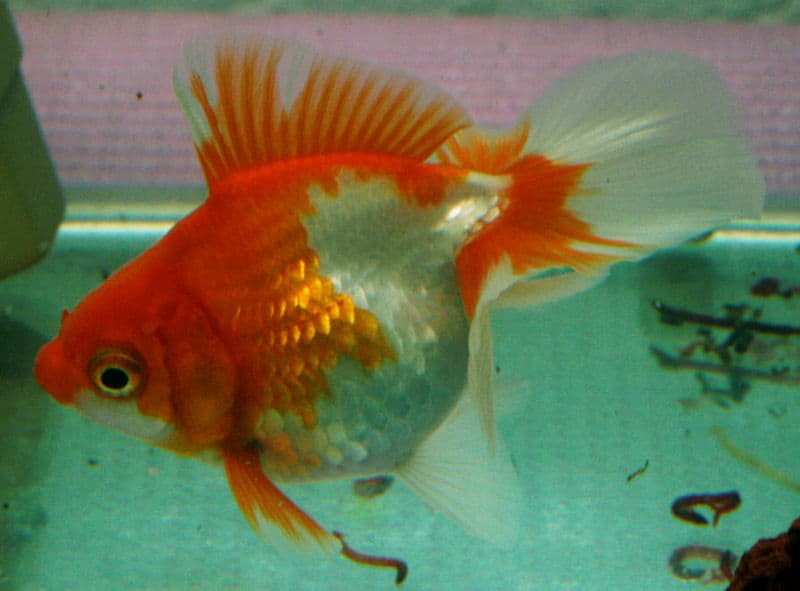
But for the devotion of a goldfish enthusiast by the name of Hiroe Tamura, this breed may very well have gone extinct. After earthquakes, a tsunami and World War II decimated the region in Japan where they were originally bred, Mr. Tamura risked his life to retrieve 6 living fish from Kochi Prefecture and re-establish the breed.
This rare goldfish is almost never found outside of Japan. The Tosakin looks like a hunched-back Ryukin but has a magnificent wide-spread double tail that is attached instead of separated. When viewed from above, their tails spread around their rear like a flowing skirt.
Breed
Tosakin Goldfish, Peacock Tail, Curly Tail
Unique Trait
Ryukin-style hunched back, compact body with long, widespread attached double tail best viewed from above
Care Level
Hard
Ideal Diet
Best fed a diet of commercial goldfish pellets that float since these fish don’t swim well, supplemented with live/frozen foods such as bloodworms
Scale Type
Metallic is more common but nacreous fish have recently appeared
Pattern
Self-colored and bi-colored
Colors
Red, black or Red and White. Calico is a much rarer morph
Average Size
1 to 2 inches for juveniles; 4 to 8 inches in length at maturity
Minimum Tank Size
10 gallons for juvenile; 20 gallons long for adult; this breed does best in shallow water no deeper than 10-inches
Add 10 gallons per adult
Ok for Ponds
No
Temperature Range
65 to 78°F; best to maintain temperature with a heater
Compatibility with Tank Mates
Should only be housed with other Tosakins
Ranchu
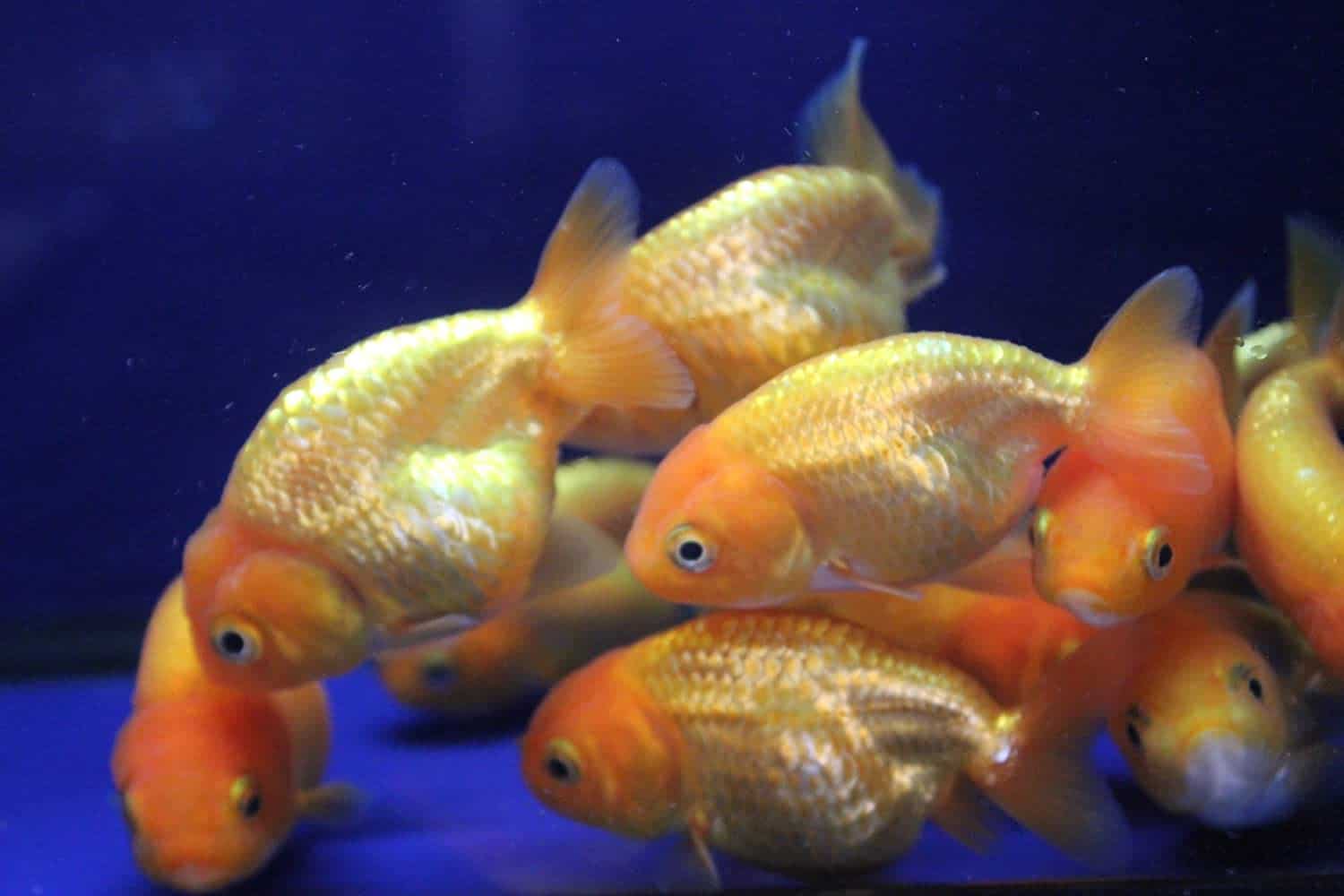
The magnificent Ranchu is of the oldest breeds and is known as the “King of the Goldfish” in Japan because they are so highly valued. It’s easy to mistake these fish for Lionheads, which they closely resemble. However, the Ranchu has a less-prominent hood and a broader back.
The Ranchu does not have a dorsal fin, which means they are not great at maneuvering in the water or hunting for food. These delicate goldfish do best in a temperature-stabilized aquarium with similar types of goldfish.
Breed
Ranchu Goldfish, King of the Goldfish, Buffalo Head Goldfish
Unique Trait
Very round compact body with a slight hunch, no dorsal fin, wide-spread double tail with a hood or growth covering the head
Care Level
Hard
Ideal Diet
Best fed a diet of commercial goldfish pellets that float since these fish don’t swim well, supplemented with live/frozen foods such as bloodworms or brine shrimp
Scale Type
Metallic only. The nacreous form is a separate breed (Edonishiki)
Pattern
Bi-colored is preferred but self-colored fish are available
Colors
Red and White or Gold and White are preferred. Also comes in white, black and red/yellow forms
Average Size
1 to 2 inches for juveniles; 5 to 8 inches in length at maturity
Minimum Tank Size
10 gallons for juvenile; 15 to 20 gallons for adult
Add 10 gallons per adult
Ok for Ponds
No
Temperature Range
65 to 78°F; best to maintain temperature with a heater
Compatibility with Tank Mates
Should only be housed with other delicate fancy goldfish like Lionheads, Celestial or Bubble Eyes
Lionhead Goldfish
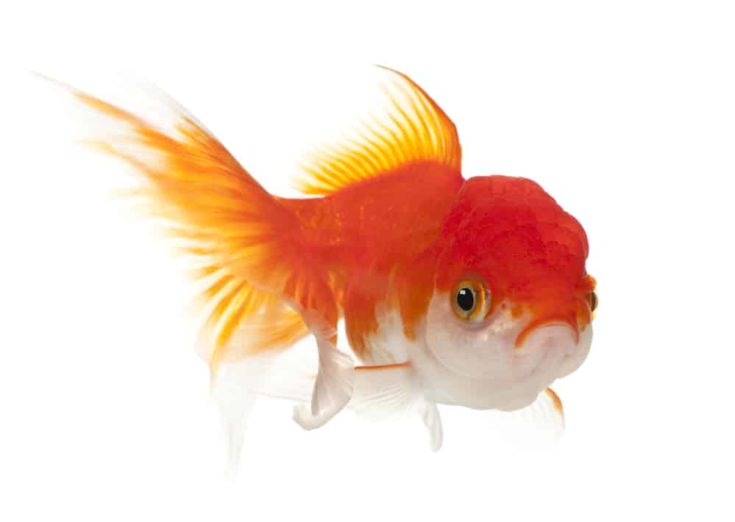
The most popular breed of dorsal-less goldfish is the stunning Lionhead. These delicate fancy fish look similar to the Ranchu but have a flatter back and the classic double tail. They often have a prominent hood that can cover their entire head and face, but this trait is sometimes limited to the top of the head or missing entirely.
Their missing dorsal fin makes these guys awkward swimmers and they do best in warmer aquariums and when kept with other fragile breeds of goldfish.
Lionchu Goldfish
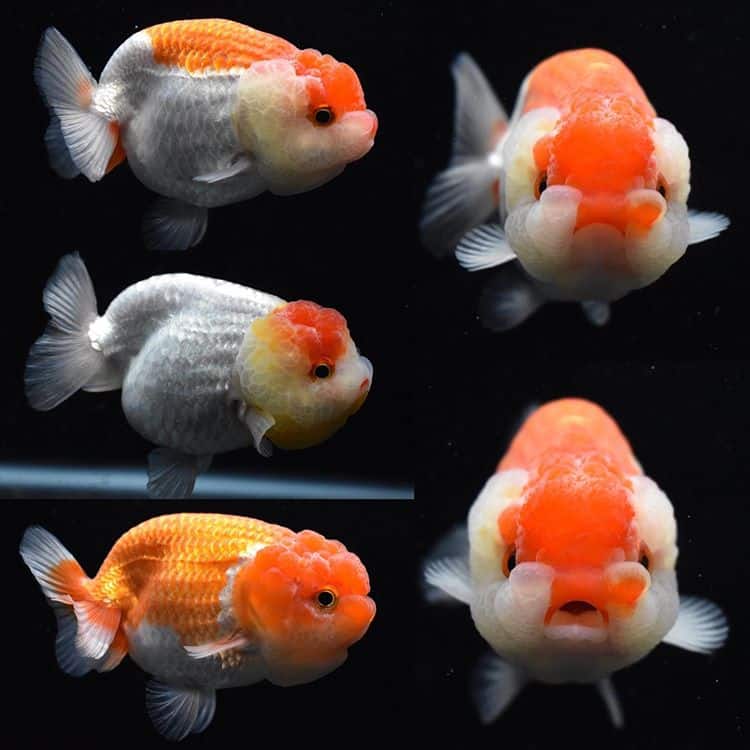
If this goldfish’s name makes you think it’s a cross between a Ranchu and Lionhead, you’d be correct! These goldfish are not, properly speaking, a separate breed but rather a hybrid. Their body is similar to the Ranchu but they have the head growth and fantail of a Lionhead. Their care requirements are identical, however.
Breed
Lionhead Goldfish and Lionchu Goldfish (Lionhead hybrid)
Unique Trait
Round compact body, no dorsal fin, classic double tail with a hood or growth covering the head
Lionchu hybrid has a body like a Ranchu with the head and fantail of a Lionhead
Care Level
Hard
Ideal Diet
Best fed a diet of commercial goldfish pellets that float since these fish don’t swim well, supplemented with live/frozen foods such as bloodworms or brine shrimp
Scale Type
Metallic or nacreous
Pattern
Self-colored, bi-colored, tri-colored or calico
Colors
Red, orange, chocolate, black, blue, calico, Red and White or Black and White
Average Size
1 to 2 inches for juveniles; 5 to 8 inches in length at maturity
Minimum Tank Size
10 gallons for juvenile; 15 to 20 gallons for adult
Add 10 gallons per adult
Ok for Ponds
No
Temperature Range
65 to 78°F; best to maintain temperature with a heater
Compatibility with Tank Mates
Should only be housed with other delicate fancy goldfish like Ranchu, Celestial or Bubble Eyes
Oranda Goldfish
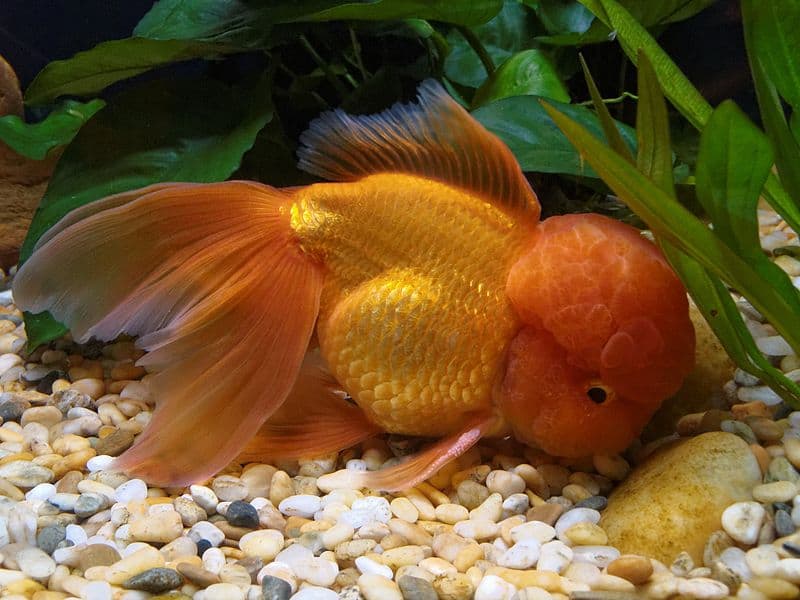
While this fish is often mistaken for a Lionhead, you can immediately spot the difference between breeds by looking for the dorsal fin. If it has one, it’s an Oranda. These popular goldfish usually have a prominent hood over their face or on their head, and the round body and double tail of the typical fancy.
The Oranda comes in a wide variety of color morphs and is often mixed with other types to create new breeds. The red capped color morph is the most common and is what most folks picture when they think of an Oranda, but many newer forms, like a pale silver/blue, have recently been developed.
Breed
Oranda Goldfish, Tigerhead or Tiger Goldfish
Unique Trait
The round compact body often with a slight hutch, classic double tail with a hood or growth covering the head
Care Level
Moderate to Hard
Ideal Diet
Best fed a diet of commercial goldfish pellets that float since these fish don’t swim well, supplemented with live/frozen foods such as bloodworms or brine shrimp
Scale Type
Metallic, matte or nacreous. The nacreous form is sometimes listed as a separate breed but this varies
Pattern
Self-colored, bi-colored or calico most common. Red capped Oranda are the most popular and in-demand morph
Colors
Red, chocolate, black, blue, calico or Red and White are the most common colors but many others may be available
Average Size
2 to 4 inches for juveniles; 7 to 9 inches in length at maturity
Minimum Tank Size
10 gallons for juvenile; 15 to 20 gallons for adult
Add 10 gallons per adult
Ok for Ponds
No
Temperature Range
65 to 78°F; best to maintain temperature with a heater
Compatibility with Tank Mates
Should only be housed with other delicate fancy goldfish like Ranchu, Lionhead, Celestial or Bubble Eyes
Telescope Goldfish
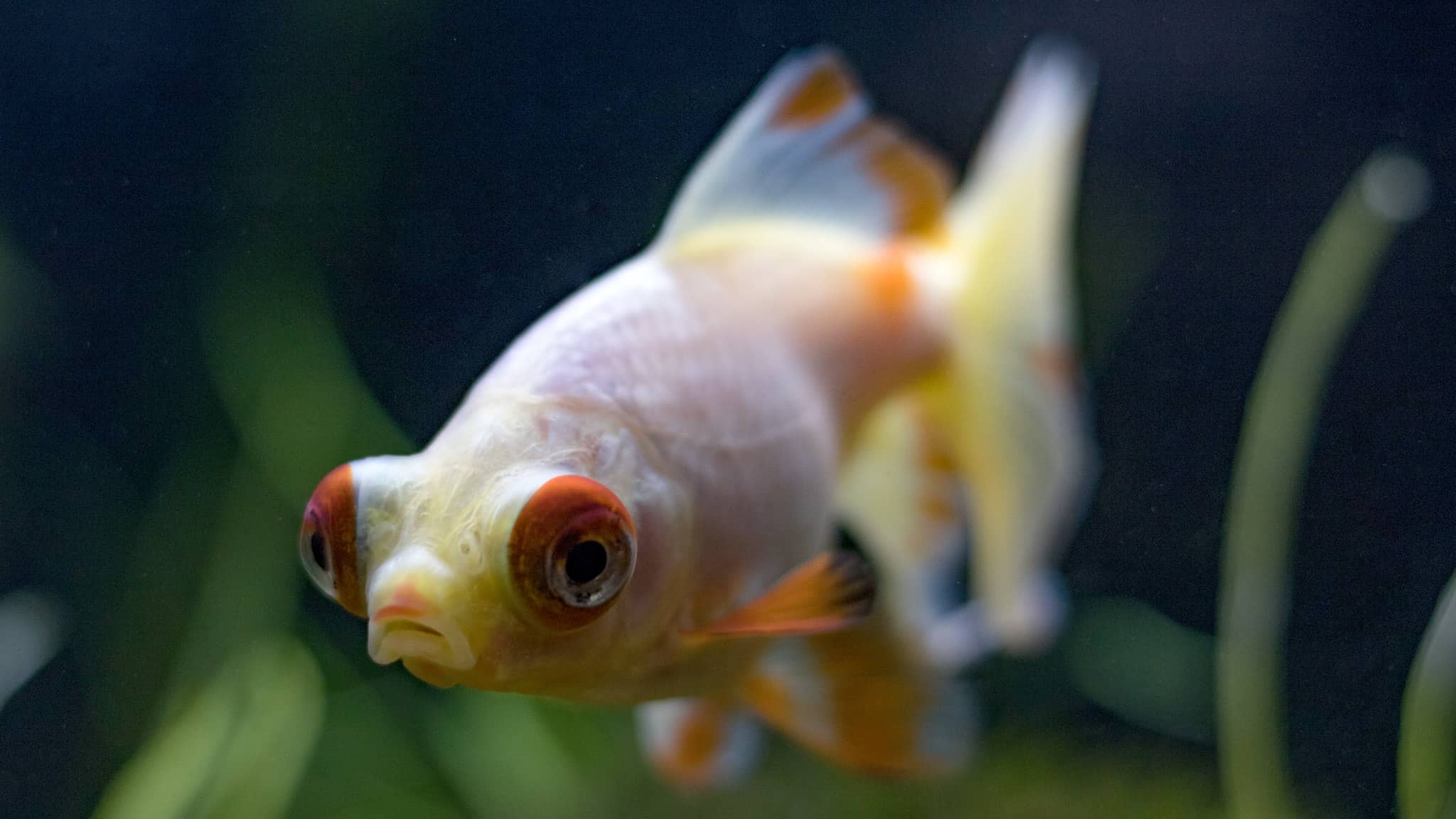
If you want a goldfish with a comic, bulge-eye appearance, then one of the many varieties of the Telescope goldfish could be the right option for your tank. These fish look very similar to the Fantails but are slightly smaller. Their distinctive features are the eyes, which look like they pop out of their heads!
Some fish just have a mild version of the trait, so their eyes appear dome-shaped but not truly telescopic. The Black Moor below is an example. Others have eyes which bulge a lot more or really stick far out from their faces. The Celestial is an extreme version of a Telescope goldfish.
Dragon Eye Goldfish
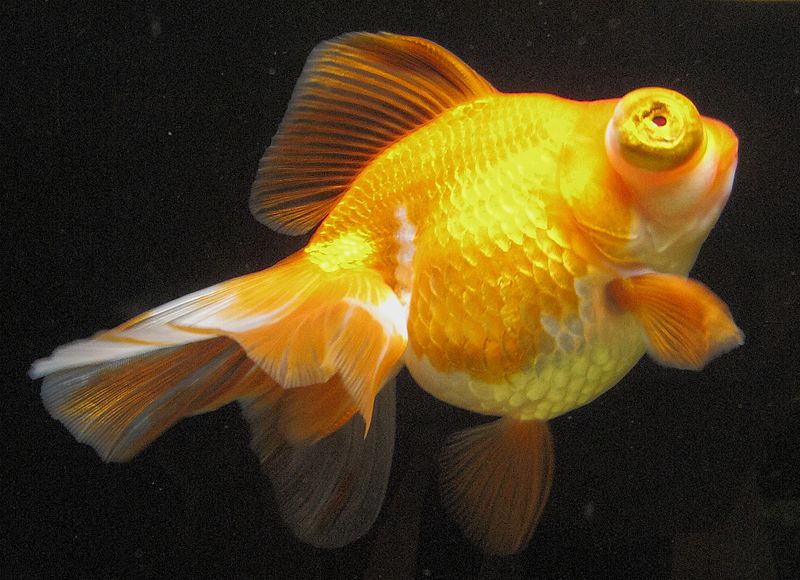
When a Telescope goldfish has especially cone-shaped eyes that really stick out from their faces they’re often called Dragon Eye goldfish. It’s thought that this was the original form in China, but the Japanese have also bred many versions that have become quite popular here in the US.
Black, Red and Panda Moor Goldfish
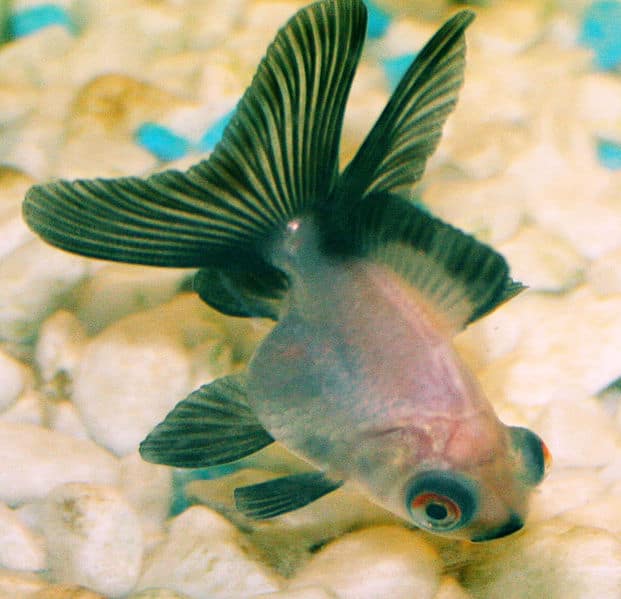
A juvenile black goldfish from a telescopic line is likely to be listed as a Black Moor. This is not a stable color morph, because many (but not all) of these fish lose their melanophores as they mature. A Black Moor most commonly fades into the bi-colored Black and White or Panda morph.
Sometimes these fish inherit an underlying red/orange color. When the black fades they turn into a Red and Black colored fish known as the Red Panda! If they lose all the melanophores they’re called a Red Moor. They are usually heartier than other telescopic fish and can sometimes be maintained in a pond or unheated aquarium.
Breed
Telescope Goldfish, Dragon Eye Goldfish
Black, Red and Panda Moors
Unique Trait
Egg-shaped body with the classic double tail and eyes which stick out from their heads. Dragon eye variety usually has much more cone-shaped eye protuberances that stick out further.
The Black/Red/Panda Moor are identical to the other types but are distinguished by their mature color morph
Care Level
Moderate to Hard
Ideal Diet
Best fed a diet of commercial goldfish pellets that float since these fish don’t swim well, supplemented with live/frozen foods such as bloodworms or brine shrimp
Scale Type
Metallic and nacreous
Pattern
Self-colored, bi-colored, tri-colored or calico
Black Moors are self-colored but may fade into red or bi-colored Panda morph upon maturity
Colors
Red, chocolate, blue, white, calico, White and Red
Moors are black and may fade to a red, Black and White or Black and Red morph
Average Size
2 to 4 inches for juveniles; 7 to 9 inches in length at maturity
Minimum Tank Size
10 gallons for juvenile; 15 to 20 gallons for adult
Add 10 gallons per adult
Ok for Ponds
No for Telescope and Dragon Eye, but some Black Moors are hearty enough for pond life
Temperature Range
68 to 78°F; best to maintain temperature with a heater
Moors can handle 60 to 78°F
Compatibility with Tank Mates
Should only be housed with other delicate fancy goldfish like Ranchu, Lionhead, Celestial or Bubble Eyes
Pearlscale Goldfish
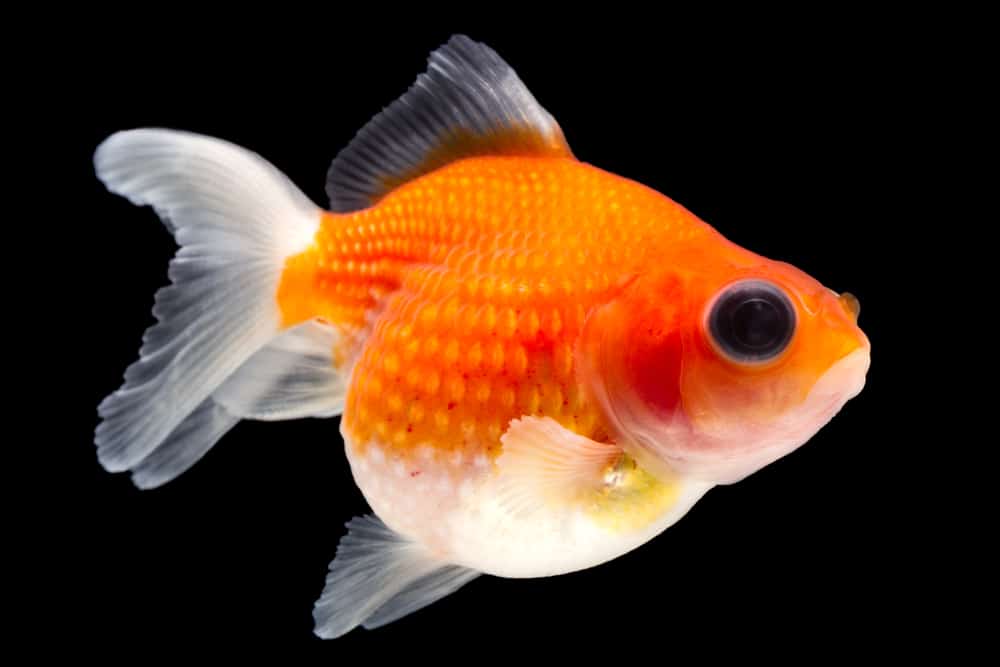
If you have a thing for unique fish then you’ll really want to take a look at the Pearlscale goldfish! This variety has the nacreous trait and is usually calico colored. This breed is the exception to the rule, however, because it also comes in self and bi-colored varieties! They’re often calico but Red and White morphs are common.
Their outstanding scales have high levels of calcium deposited in them which makes each scale stand out on your fish’s body. They look like they have been covered in tiny pearls! This is the only variety of goldfish with these unique and distinctive scales.
Breed
Pearlscale Goldfish
Unique Trait
Round, compact ping pong ball-like body, classic double tail. May have other fancy traits like a hood or telescope eyes. The nacreous scales with heavy calcium deposits is what distinguishes this from other breeds
Care Level
Moderate
Ideal Diet
Best fed a diet of commercial goldfish pellets that float since these fish don’t swim well, supplemented with live/frozen foods such as bloodworms or brine shrimp
Scale Type
Nacreous with large calcium deposits that make each scale stand out on the body and look like little pearls
Pattern
Self-colored, bi-colored or calico
Colors
Red, white, chocolate, black, blue, calico or Red and White are the most common
Average Size
1 to 2 inches for juveniles; 4 to 6 inches in length at maturity
Minimum Tank Size
10 gallons for juvenile; 15 to 20 gallons for adult
Add 10 gallons per adult
Ok for Ponds
No
Temperature Range
65 to 72°F; best to maintain temperature with a heater
Compatibility with Tank Mates
Should only be housed with other delicate fancy goldfish like Ranchu, Lionhead, Celestial or Bubble Eyes
Pompom Goldfish
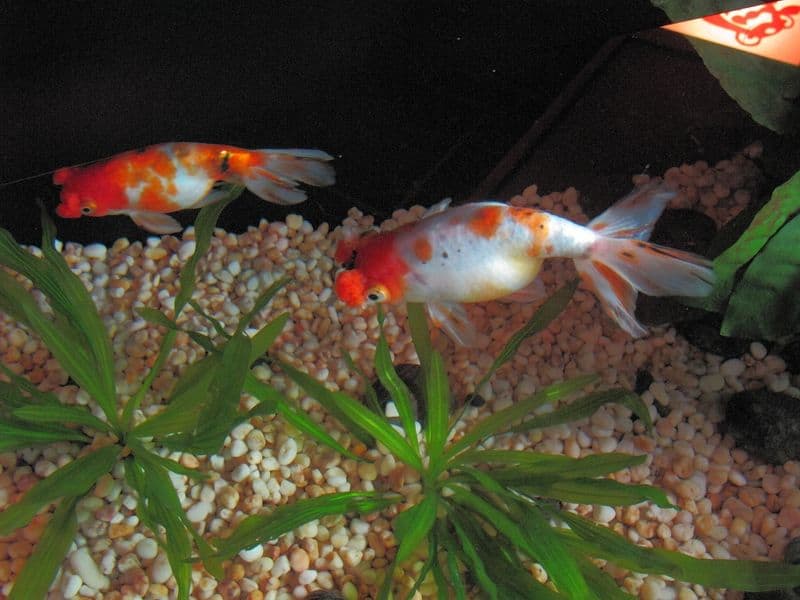
As I mentioned in the morphology section, many breeds of goldfish have nasal appendages on their faces. The typical pompom has the egg-shaped fancy body and double tail, no dorsal fin and prominent narial growths on both sides of its face. Pompoms often come with other fancy traits such as a hood or telescope eyes.
Pompoms are frequently crossed with Oranda, Bubble Eye, and Fantails to create new varieties. These matings have led to Pompoms with dorsal fins. Most Pompoms are very delicate and their extra facial tissue puts them at risk of injury and infection.
Breed
Pompom Goldfish (Pompon in Japan)
Unique Trait
Compact egg-shaped body, no dorsal fin, classic double tail, two pom pom growths which may hang or float over the head. May have other fancy traits like a hood, telescope or bubble eyes
Some varieties, such as the Fantail Pompom, may inherit a dorsal fin but this breed typically doesn’t have them
Care Level
Hard
Ideal Diet
Best fed a diet of commercial goldfish pellets that float since these fish don’t swim well, supplemented with live/frozen foods such as bloodworms or brine shrimp
Scale Type
Metallic is most common and nacreous is rare
Pattern
Self-colored, bi-colored or tri-colored most common but calico morphs may be available
Colors
Red, white/silver, black, calico or Red and White are the most common
Average Size
1 to 2 inches for juveniles; 4 to 6 inches in length at maturity
Minimum Tank Size
10 gallons for juvenile; 15 to 20 gallons for adult
Add 10 gallons per adult
Ok for Ponds
No
Temperature Range
68 to 78°F; best to maintain temperature with a heater
Compatibility with Tank Mates
Should only be housed with other delicate fancy goldfish like Ranchu, Lionhead, Celestial or Bubble Eyes
Bubble Eye Goldfish
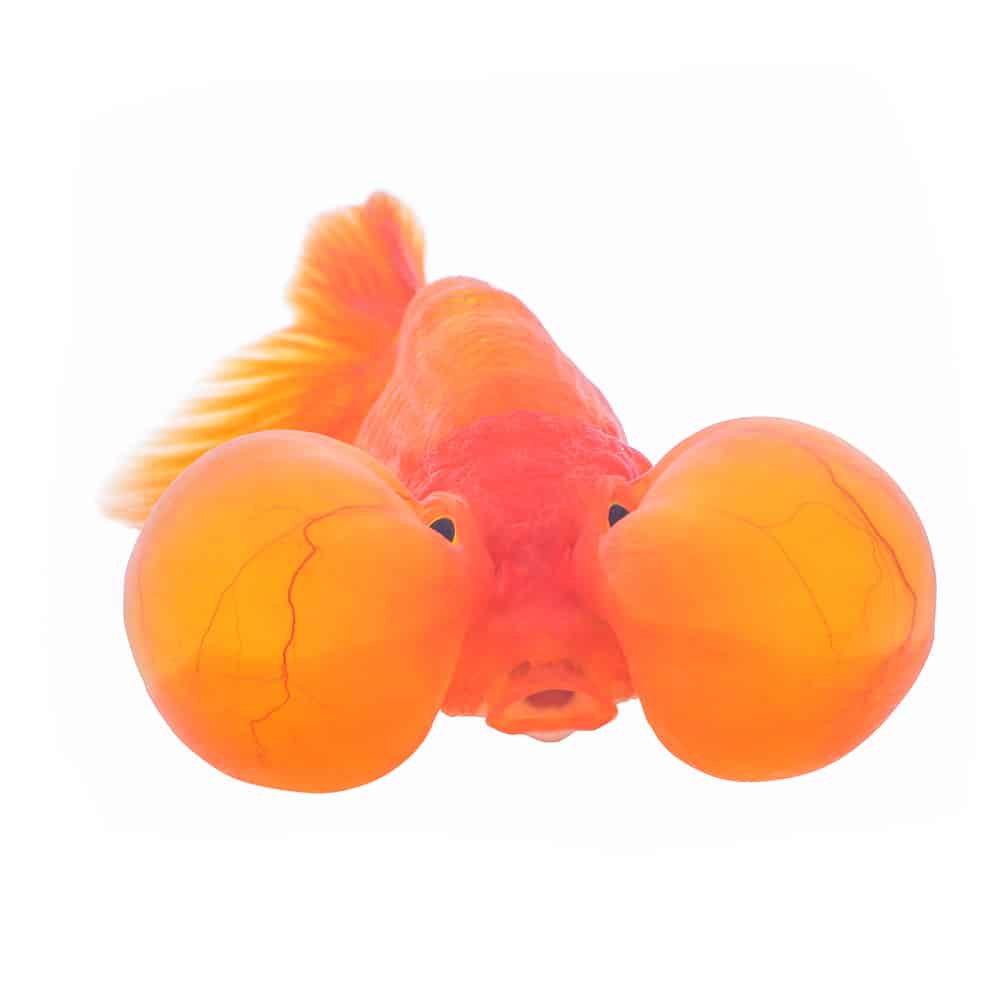
One of the most fascinating fancy goldfish breeds is the Bubble Eye. They have large water-filled sacks of flesh bulging from underneath their eyes. As your fish matures the bubbles get bigger and can even obscure their vision! These awkward swimmers are very delicate and are one of the hardest goldfish to care for.
The Bubble Eyes are usually missing their dorsal fin, which makes it hard for them to maneuver around your tank. Their bubbles can be injured by aquarium filters and decorations, so you’ll need a very open and safe tank design to keep them healthy.
Breed
Bubble Eye Goldfish
Unique Trait
Compact egg-shaped body, no dorsal fin, classic double tail, prominent fluid-filled bubble sacks under each eye. May have other fancy traits like a hood, telescope eyes and long tail
Care Level
Hard
Ideal Diet
Best fed a diet of commercial goldfish pellets that float since these fish don’t swim well, supplemented with live/frozen foods such as bloodworms or brine shrimp
Scale Type
Metallic or nacreous
Pattern
Self-colored, bi-colored or calico
Colors
Red, black, chocolate, blue, calico or Red and White/Red and Black
Average Size
1 to 2 inches for juveniles; 4 to 6 inches in length at maturity
Minimum Tank Size
10 gallons for juvenile; 15 to 20 gallons for adult
Add 10 gallons per adult
Ok for Ponds
No
Temperature Range
68 to 78°F; best to maintain temperature with a heater
Compatibility with Tank Mates
Should only be housed with other delicate fancy goldfish like Ranchu, Lionhead, Celestial or other Bubble Eyes
Celestial Eye or Stargazing Goldfish
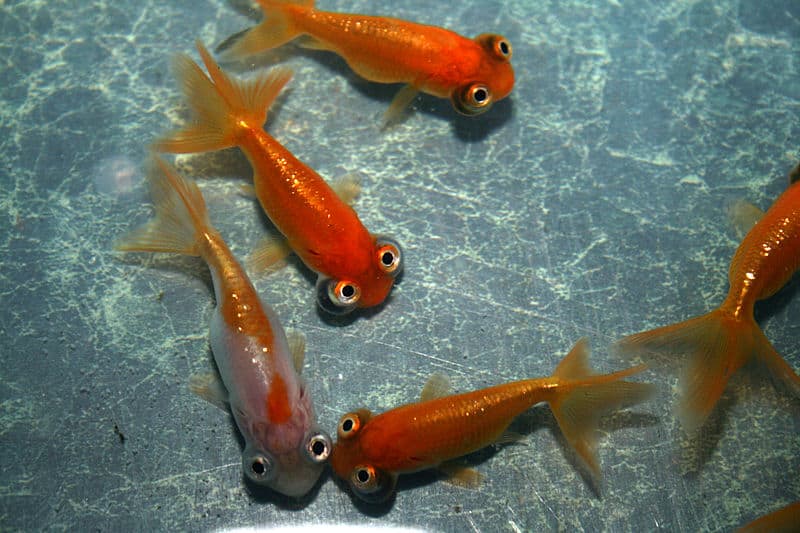
The most challenging fancy goldfish to maintain is the Celestial Eye. These fish are best left to experienced aquarists. They have a typical fancy body and double tail, no dorsal fin and prominent telescopic eyes. Their eyes face upwards, towards the top of their tanks. This makes them very light sensitive!
Celestials need an aquarium that isn’t too bright, and definitely need their light off at night so they can sleep. They are even more sensitive to their water quality than other breeds and are prone to many health problems.
Breed
Celestial Eye Goldfish, Stargazing Goldfish
Unique Trait
Compact egg-shaped body, no dorsal fin, classic double tail, telescopic upturned eyes. May have other fancy traits like a hood, pompoms or a long tail
Care Level
Very Hard
Ideal Diet
Best fed a diet of commercial goldfish pellets that float since these fish don’t swim well, supplemented with live/frozen foods such as bloodworms or brine shrimp
Scale Type
Metallic or nacreous
Pattern
Self-colored or calico
Colors
Red/orange, black and calico
Average Size
1 to 2 inches for juveniles; 4 to 6 inches in length at maturity
Minimum Tank Size
10 gallons for juvenile; 15 to 20 gallons for adult
Add 10 gallons per adult
Ok for Ponds
No
Temperature Range
68 to 78°F; best to maintain temperature with a heater
Compatibility with Tank Mates
Should only be housed with other delicate fancy goldfish like Ranchu, Lionhead, Pompom or Bubble Eyes
Rare Breeds of Fancy Goldfish
I wasn’t able to find out much information about the following goldfish varieties, as many of them are only bred in Asia and are not usually available in aquarium shops. If you’ve seen or kept any of these rare breeds, I’d love to hear about your experiences!
Izumo Nankin
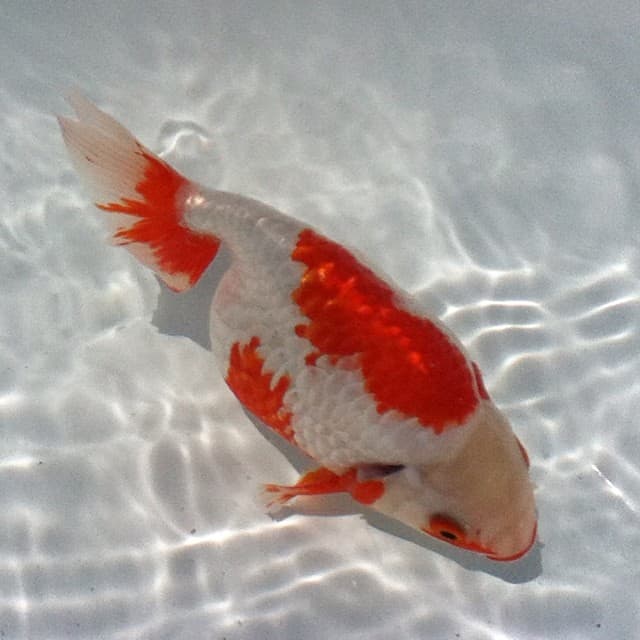
This rare Japanese breed is almost never seen in the west. The Izumo Nankin is a top-viewed bi-colored Red and White dorsal-less goldfish with a partially fused Ranchu-style tail.
Curled-Gill Goldfish
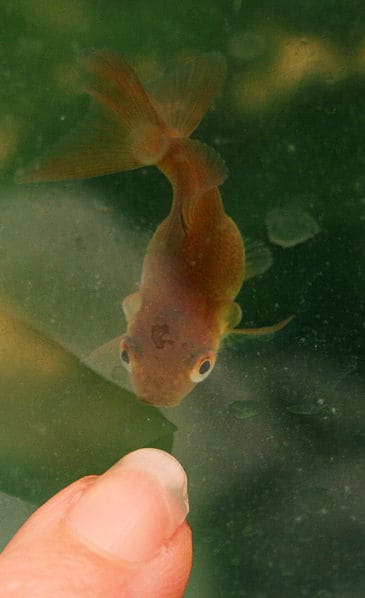
Curled gills are a mutation that causes the gill cover to curl out and away from the gills, exposing them and making them visible. It is an undesirable trait and breeders cull it from their stock. If you see this type of fish in an aquarium store it’s recommended you don’t purchase them, as they are likely to be unhealthy.
Eggfish, Egg-Fish or Maruko Goldfish
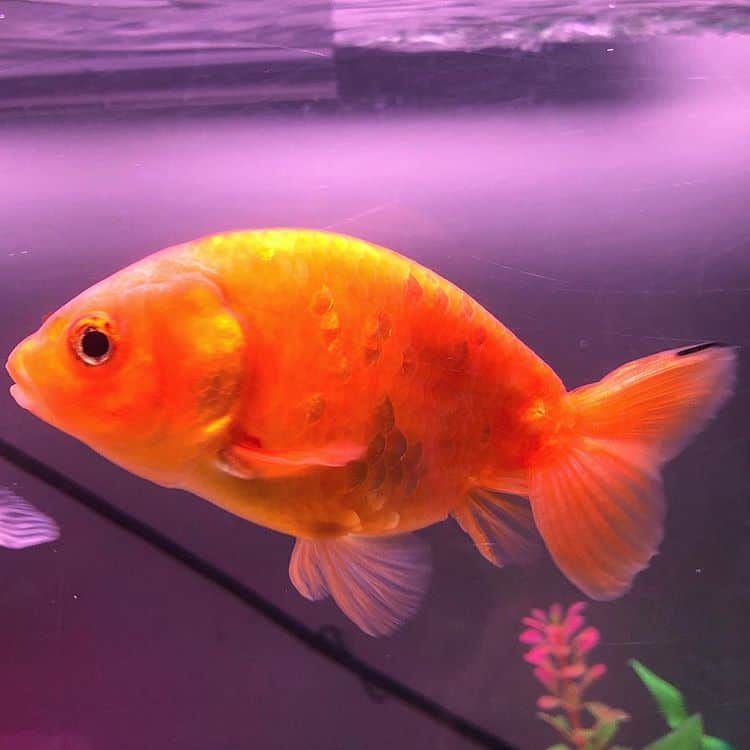
Thought to be the ancestor of the dorsal-less line of goldfish, the eggfish or Maruko is not currently available for purchase. Some goldfish fanciers have been trying to reestablish the line from Ranchu stock but their offspring haven’t hit the commercial market yet.
Siamese Doll Goldfish
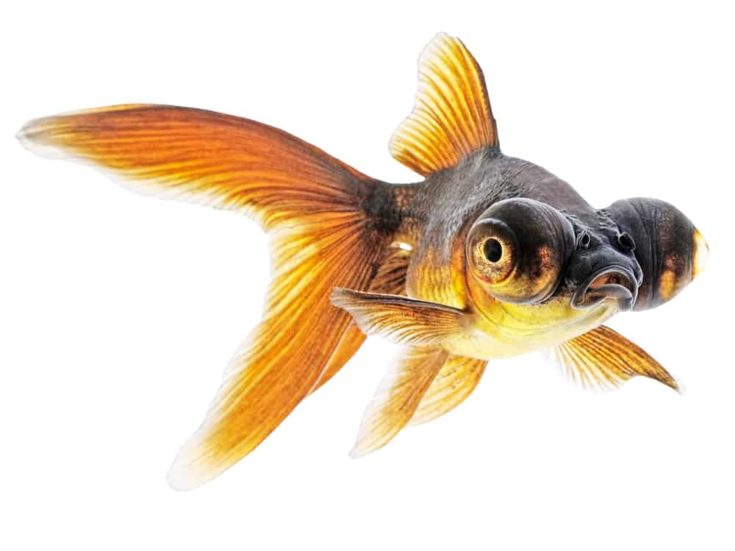
The Siamese Doll is a rare type of Fantail with a distinctive yellow coloration also known as a Lutino morph. I’ve never seen this type of goldfish for sale but they may be more common overseas.
Jade Seal Goldfish
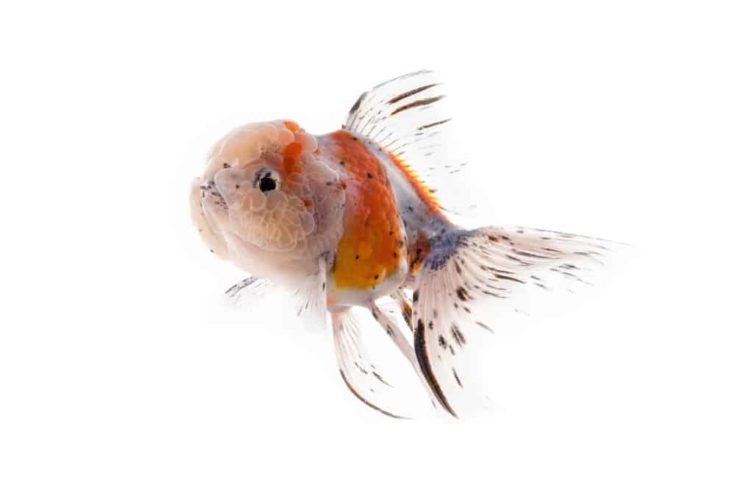
The Jade Seal is an older breed of goldfish that is not currently available. They are basically a Red Oranda with a White Cap.
Conclusion
It might seem overwhelming to have such a long list of options when choosing fish for your goldfish habitat. Luckily, despite the wide variety in colors and fancy traits, goldfish are pretty easily divided into groups based on their care requirements. I hope this comprehensive guide to goldfish breeds has helped you find the perfect match!
Choosing a goldfish starts by deciding if you’re stocking a pond or aquarium:
- The single tail fish are ideal for pond life, but some of the fancy breeds like the Butterfly, Jikin and Ryukin do well in ponds too.
- Any of the goldfish on my list makes a great option for a 30 to 50-gallon aquarium, though some are better choices for new aquarists and others ideal for experienced fish keepers.
We’d love to hear about the breeds of goldfish you’ve raised in the comments, or follow us on social media. Please let me know if you have any experience with rare types of Asian goldfish like the Izumo!
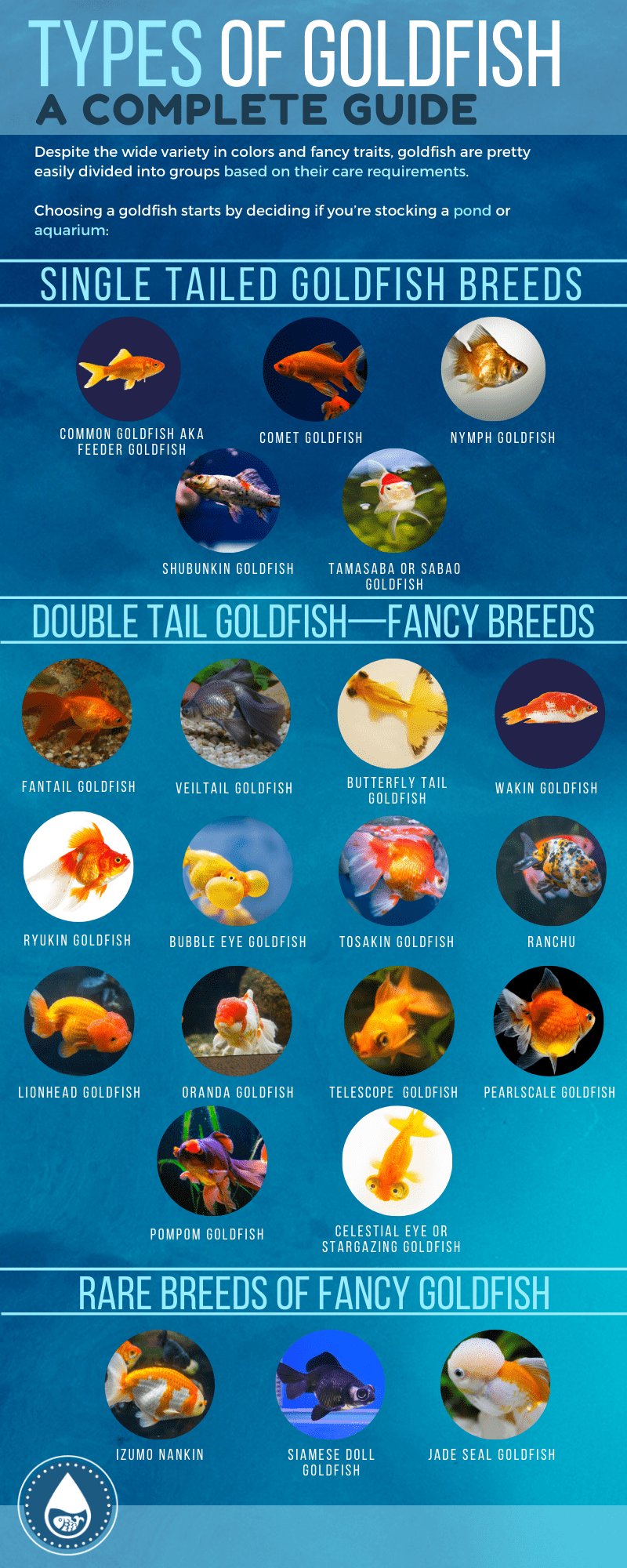
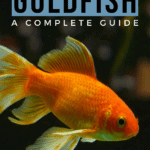
Happy to read such detailed and exhaustive variety of Gold fish.
Thank you for your effort and time and have learnt alot.
Best regards
I have a black goldfish with a gold underbelly bought 10 year’s ago as a normal size 2 inch fish. It has now grown to about 12 inch and still growing. Can you tell me how big this fish will grow as I have not long bought a 240 ltr tank and it looks like I may have size up again.
Thanks Gary